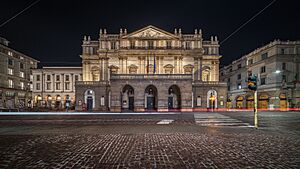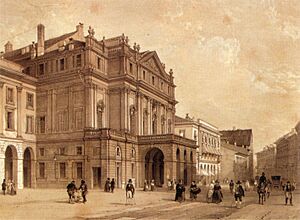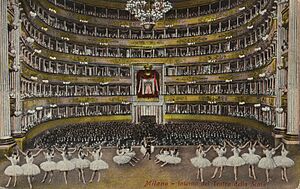La Scala facts for kids
 |
|
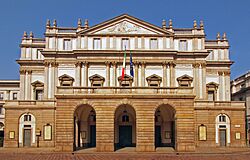
Exterior of La Scala
|
|
| Address | Piazza della Scala, Milan, Italy |
|---|---|
| Coordinates | 45°28′03″N 09°11′21″E / 45.46750°N 9.18917°E |
| Owner | City of Milan |
| Capacity | 2,030 |
| Construction | |
| Opened | 1778 |
| Architect | Giuseppe Piermarini |
La Scala (officially called Teatro alla Scala) is a very famous opera house in Milan, Italy. It opened on August 3, 1778. It was built on the site of an old church, which is how it got its name. The very first show performed there was an opera called Europa riconosciuta by Antonio Salieri.
Many of Italy's best opera singers and dancers, along with famous artists from all over the world, have performed at La Scala. It is known as one of the top opera and ballet theaters globally. La Scala has its own chorus, ballet company, and two orchestras. It also has a special school, the La Scala Theatre Academy, where young people can learn about music, dance, and how to work behind the scenes in theater.
Contents
About La Scala
The opera season at La Scala always begins on December 7. This day is special in Milan because it's Saint Ambrose's Day, the city's patron saint. All performances must finish before midnight. If an opera is very long, it starts earlier in the evening.
Inside the theater, you can visit the Museo Teatrale alla Scala (La Scala Theatre Museum). It has a collection of paintings, costumes, and other items that show the history of La Scala and opera. The theater also has an academy that trains new musicians, dancers, and technical staff.
Above the main seating areas, La Scala has a special gallery called the loggione. This is where people who are very passionate about opera often sit. These fans, called loggionisti, can be very excited or very critical of the singers. If a singer makes a mistake, they might get a "baptism of fire" from these fans. For example, in 2006, a singer named Roberto Alagna left the stage after the audience booed him during a show. His backup singer had to quickly take his place.
History of the Opera House
Before La Scala, there was another theater called the Teatro Regio Ducale. It was destroyed by a fire on February 25, 1776. A group of wealthy people in Milan, who owned private boxes in the old theater, asked for a new one to be built.
The famous architect Giuseppe Piermarini designed the new theater. His first design was not accepted, but his second plan was approved in 1776. The new theater was built on the site of an old church called Santa Maria della Scala. This is how the theater got its name. It took two years to build.
La Scala had about 3,000 seats. These were arranged in six levels of boxes, plus two galleries. The stage was one of the largest in Italy. The owners of the boxes decorated them beautifully. La Scala quickly became a popular meeting place for important people in Milan. In those days, the main floor had no chairs, so people stood to watch the shows. The orchestra was also in full view, as there was no orchestra pit yet. Like many theaters back then, La Scala also had a casino where people gambled in the lobby.
At first, La Scala was lit by 84 oil lamps on stage and a thousand more throughout the theater. To prevent fires, many rooms had buckets of water. Later, gas lamps replaced the oil lamps, and then electric lights were installed in 1883.
The building was updated in 1907 and given its current layout with 1,987 seats. During World War II, in 1943, La Scala was badly damaged by bombs. It was rebuilt and reopened on May 11, 1946. A famous conductor named Arturo Toscanini led a memorable concert for the reopening.
La Scala has hosted the first performances of many famous operas. The composer Giuseppe Verdi had a special connection with the theater. For a while, he did not allow his music to be played there because he felt the orchestra had changed it. However, he later conducted his Requiem there in 1874. He also chose La Scala for the first performances of his operas Otello and Falstaff.
Filarmonica della Scala Orchestra
In 1982, the Filarmonica della Scala orchestra was created. Its goal was to perform symphonic music in addition to the opera performances. This orchestra is made up of musicians from the larger Orchestra della Scala. Many great conductors have led the Filarmonica, including Carlo Maria Giulini and Riccardo Muti.
Recent Changes and Events
Major Renovation (2002-2004)
La Scala underwent a big renovation from early 2002 to late 2004. The theater closed after its traditional season opening on December 7, 2001. The opera company moved to a new theater, the Teatro degli Arcimboldi, during this time.
The renovation was led by architect Mario Botta. Some people worried that historic details would be lost. However, the opera company was happy with the improvements. The sound quality got better when heavy red carpets were removed. The stage was completely rebuilt, and a larger backstage area now allows more sets to be stored.
The seats now have small screens that show the opera's words in English, Italian, and the original language. La Scala reopened on December 7, 2004, with a performance of Salieri's Europa riconosciuta. This was the same opera that opened the theater in 1778. Tickets for the reopening were very expensive. The renovations cost about €61 million.
From 2005 Onward
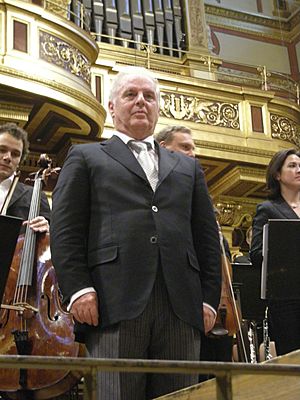
In February 2005, Carlo Fontana, the general manager, was dismissed because of disagreements with the music director, Riccardo Muti. This caused problems and staff strikes. On April 2, 2005, Muti resigned from La Scala, saying he felt "hostility" from the staff.
In May 2005, Stéphane Lissner became the new General Manager and artistic director. He was the first non-Italian to hold this position. In 2006, Daniel Barenboim was named the main guest conductor. He later became the music director in December 2011. In December 2013, Riccardo Chailly was named the next music director, starting in 2015.
Stéphane Lissner left La Scala for the Paris Opera. Alexander Pereira took over in October 2014. In June 2019, it was announced that Dominique Meyer would replace Pereira in 2020. La Scala was supposed to host the opening ceremony for the 134th IOC Session in 2019. However, the event was moved to Switzerland because Milan was bidding to host the 2026 Winter Olympics.
Main Conductors and Music Directors
- Antônio Carlos Gomes (1836–1896)
- Franco Faccio (1871–1889)
- Arturo Toscanini (1898–1903)
- Cleofonte Campanini (1903–1905)
- Leopoldo Mugnone (1905–1906)
- Arturo Toscanini (1906–1907)
- Edoardo Vitale (1907–1910)
- Tullio Serafin (1910–1914)
- Gino Marinuzzi (1914–1917)
- Tullio Serafin (1917–1918)
- La Scala was closed from 1918 to 1920
- Arturo Toscanini (1921–1929)
- Victor de Sabata (1929–1953)
- Carlo Maria Giulini (1953–1956)
- Guido Cantelli (1956)
- Antonino Votto (1956–1965)
- Gianandrea Gavazzeni (1965–1968)
- Claudio Abbado (1968–1986)
- Riccardo Muti (1986–2005)
- The position was vacant from April 2005 to December 2007
- Daniel Barenboim (2007–2014)
- Riccardo Chailly (2015–present)
- Myung-Whun Chung (designated, 2027–)
First Performances at La Scala
- See: Category:Opera world premieres at La Scala
- 1778: Europa riconosciuta by Antonio Salieri
- 1794: Demofoonte by Marcos Portugal
- 1800: Idante, ovvero I sacrifici d'Ecate by Marcos Portugal
- 1812: La pietra del paragone by Gioachino Rossini
- 1813: Aureliano in Palmira by Gioachino Rossini
- 1814: Il turco in Italia by Gioachino Rossini
- 1820: Margherita d'Anjou by Giacomo Meyerbeer
- 1827: Il pirata by Vincenzo Bellini
- 1829: La straniera by Vincenzo Bellini
- 1831: Norma by Vincenzo Bellini
- 1833: Lucrezia Borgia by Gaetano Donizetti
- 1835: Maria Stuarda by Gaetano Donizetti
- 1839: Oberto, Conte di San Bonifacio by Giuseppe Verdi
- 1840: Un giorno di regno by Giuseppe Verdi
- 1842: Nabucco by Giuseppe Verdi
- 1843: I Lombardi alla prima crociata by Giuseppe Verdi
- 1845: Giovanna d'Arco by Giuseppe Verdi
- 1868: Mefistofele by Arrigo Boito
- 1870: Il Guarany by Antônio Carlos Gomes
- 1873: Fosca by Antônio Carlos Gomes
- 1876: La Gioconda by Amilcare Ponchielli
- 1879: Maria Tudor by Antônio Carlos Gomes
- 1885: Marion Delorme by Amilcare Ponchielli
- 1887: Otello by Giuseppe Verdi
- 1889: Edgar by Giacomo Puccini
- 1892: La Wally by Alfredo Catalani
- 1893: Falstaff by Giuseppe Verdi
- 1904: Madama Butterfly by Giacomo Puccini
- 1924: Nerone by Arrigo Boito
- 1926: Turandot by Giacomo Puccini
- 1957: Dialogues of the Carmelites by Francis Poulenc
- 1981: Donnerstag aus Licht by Karlheinz Stockhausen
- 1984: Samstag aus Licht by Karlheinz Stockhausen
- 1988: Montag aus Licht by Karlheinz Stockhausen
- 2007: Teneke by Fabio Vacchi
- 2011: Quartett by Luca Francesconi
- 2025: Il nome della rosa by Francesco Filidei
See also
 In Spanish: Teatro de La Scala para niños
In Spanish: Teatro de La Scala para niños


